| Pages:
1
..
8
9
10
11
12
..
18 |
XeonTheMGPony
International Hazard
    
Posts: 1641
Registered: 5-1-2016
Member Is Offline
Mood: No Mood
|
|
Quote: Originally posted by ManyInterests  | Quote: Originally posted by XeonTheMGPony  | | try methanol for the recrystalization I add a bit to the methanol and to the water as my goal was to have it incorporated to the crystal structure as
well when doing high density crystals I directly crashed out the ETN by cooling the Methanol under high stirring |
Add a bit to the methanol and to the water? What do you mean? You add methanol to the water in addition to urea? |
Add urea to the recrystallization solvent, urea is soluble in methanol
Add small amount Urea to the iced water bath to crash the super saturated ETN / Methanol / Urea solution in to
|
|
|
ManyInterests
National Hazard
   
Posts: 966
Registered: 19-5-2019
Member Is Offline
|
|
I did hear about methanol being used as a solvent. Does it have to be hot methanol? Do you have any idea how much I might need? Methanol is cheaper
than acetone and I am out of methanol, so I might as well use it.
Edit: I read that 10g of ETN in 100ml of ethanol. is it similar to methanol? I did see that when crashed into solution it is supposed to form as
platets and not the captain crunch consistency of acetone. This sounds a lot better.
[Edited on 23-9-2022 by ManyInterests]
|
|
|
Herr Haber
International Hazard
    
Posts: 1236
Registered: 29-1-2016
Member Is Offline
Mood: No Mood
|
|
It will definitely have to be hot near boiling and stoppered if possible. There's only 10 degrees between ETN melting point and methanol boiling
point. Look at the difference in solubility between methanol and acetone. You will be using *a lot* more methanol.
Take that into account when crashing because you obviously need more water than what would be the minimum with acetone. You're using 3.5 liters so it
shouldnt be a problem unless you have a very big batch and had to use a lot of methanol.
You ***cannot* of course heat the water to drive off the methanol if you realize you still have a lot in solution.
If you've already gone through the acetone recrystallization you could also do a simple recrystallization in methanol + urea. No crashing in water.
Less hassle 
I cant say I like the crystal shape you get from methanol (platelets). Appearance is nice, usage not so much (doesnt flow as well). It also traps a
lot more water so drying takes longer and sticks a bit together. Nothing that cant be solved though.
The spirit of adventure was upon me. Having nitric acid and copper, I had only to learn what the words 'act upon' meant. - Ira Remsen
|
|
|
ManyInterests
National Hazard
   
Posts: 966
Registered: 19-5-2019
Member Is Offline
|
|
I will be putting in 3.25 liters of water first, and then dumping in the methanol dissolved ETN. If I have more space for water, I'll put it in
before.
i won't do too big a batch. If you recall, I did 'final exam' myself with ETN synth and I ended up with 84 grams of final product. I just wanted to
see if I can pull it off (and I did). I'll work with 30 gram batches at a time to make sure I don't overwhelm the water.
And methanol has a boiling point of around 65 C while ETN melts at 70C. I'll take that into consideration. I'll monitor the temperature of the
methanol and as soon as I see any bubbling I will remove from the heat source and dump it over my ETN. I will use a surplus of methanol to the ETN. So
like 350ml to the 30 grams.
|
|
|
Herr Haber
International Hazard
    
Posts: 1236
Registered: 29-1-2016
Member Is Offline
Mood: No Mood
|
|
ETN melts around 55-61 depending on purity. Methanol boils at 65 so you dont have a big margin.
Because of this you'll probably have to use more methanol than needed because you dont want to have a blob of molten ETN in methanol. And if you let
it cool then you'll have a layer of ETN stuck at the bottom of a beaker.
Not the best for the nerves and this is where acetone becomes really useful to clean and save as much material as possible from the mess because you
dont really want to scrap if off right? 
But I'm pretty sure you already figured that last part out on your own.
I'd recommend starting with a 10g batch, just so you can get used to how much methanol you'll need and how much water to crash it in. If the ratio
methanol / water is too high it'll be very obvious to you.
The spirit of adventure was upon me. Having nitric acid and copper, I had only to learn what the words 'act upon' meant. - Ira Remsen
|
|
|
ManyInterests
National Hazard
   
Posts: 966
Registered: 19-5-2019
Member Is Offline
|
|
Quote: Originally posted by Herr Haber  | ETN melts around 55-61 depending on purity. Methanol boils at 65 so you dont have a big margin.
Because of this you'll probably have to use more methanol than needed because you dont want to have a blob of molten ETN in methanol. And if you let
it cool then you'll have a layer of ETN stuck at the bottom of a beaker.
Not the best for the nerves and this is where acetone becomes really useful to clean and save as much material as possible from the mess because you
dont really want to scrap if off right? 
But I'm pretty sure you already figured that last part out on your own.
I'd recommend starting with a 10g batch, just so you can get used to how much methanol you'll need and how much water to crash it in. If the ratio
methanol / water is too high it'll be very obvious to you. |
Yeah I had that issue happen once where I needed to scrape stuff!  At any rate,
I get you. I will use a good excess of methanol. At any rate,
I get you. I will use a good excess of methanol.
Like if I want to go with my 30 grams, I will use 450 ml instead of 350. I will dump the hot methanol on top of the ETN and stir them and if I see
them all dissolved, I will dump the entire thing immediately into the water.
Edit: ETN melts at 55 to 61? I had to put my hot water bath at 70C to melt cast the ETN into my pen body. Maybe the plastic is a poor thermal
conductor. Maybe it could have melted at a lower temp, I dunno.
[Edited on 23-9-2022 by ManyInterests]
|
|
|
XeonTheMGPony
International Hazard
    
Posts: 1641
Registered: 5-1-2016
Member Is Offline
Mood: No Mood
|
|
never had it stick, I often let it cool int he methanol to form high density crytals
#1 recryst, I use a slight excess methanol so I can filter it with out head aches, to remove any solids and such, second recrsyt, I use just enough to
dissolve it all
then under steady stirring and wrapped in towel it is allowed to cool then once room temp I put it in freezer and manually stir so often.
|
|
|
ManyInterests
National Hazard
   
Posts: 966
Registered: 19-5-2019
Member Is Offline
|
|
Oh my! I made a ridicules and thoroughly irresponsible mistake... that had no negative consequences.
So instead of recrystalizing 30 grams at a time, I weighed both my batches together and accidentally put the methanol over the whole lot.
Interestingly enough, the 550ml (approximately) of boiling hot methanol was sufficient to dissolve all of them.
I then mixed it them to make sure everything is dissolved (98 grams total. 16 grams from my first batch, and the 82 from the other I believe. Seems
like keeping the other one open for a few days before doing this did cause whatever solvents to evaporate, going to 82 from 88).
I dumped the whole thing in 3.5 in ice cold water, topped off with more water, then filtered. It'll take quite a few days for everything to dry out,
but I will see what I get.
There is very little crunchiness, most of them are very, very cake like, so I predict that it's going to be a very, very fine powder once it is all
dry with no chunks or anything. Oh and I made sure to add urea to both the methanol and the water, so this should be the most hyper pure batch.
Edit: So keep a note. Aprox 550 ml will readily dissolve 98g of ETN. It took a bit of stirring (not too much) but it dissolved with what I believe are
impurities in the bottom.
[Edited on 24-9-2022 by ManyInterests]
|
|
|
XeonTheMGPony
International Hazard
    
Posts: 1641
Registered: 5-1-2016
Member Is Offline
Mood: No Mood
|
|
Actualy mixing batches is how you get good uniformity, so this allows for much more accurate loading and testing. Amount is a bit excessive, but that
just makes you need more water, so more of an annoyance aspect them levelling the house sort of oops.
|
|
|
Herr Haber
International Hazard
    
Posts: 1236
Registered: 29-1-2016
Member Is Offline
Mood: No Mood
|
|
Quote: Originally posted by OneEyedPyro  |
I've found that with ETN the critical diameter is smaller at low densities, cast doesn't seem to have stable detonation below about 8mm and it's not
for lack of a strong enough initiation.
Lightly pressed powder will detonate consistently at pretty tiny diameters though. |
1 is cast and 2 are pressed. Guess who's who. Diameter slightly above 6mm. These are very old (10 years or so). Dont recall the specifics but probably
700mg + 100 or 120mg DLA as an initiator. Sorry about the sand.
Just look at the size of the fragments. I would call the pressed ones failures.
That's why I disagree when I read statements like the above one. Never tried powder in tiny diameters though.
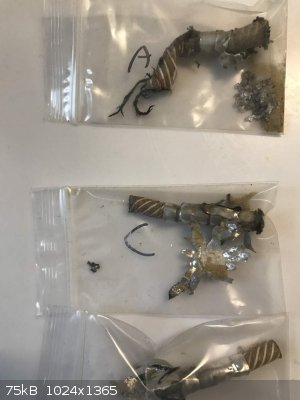 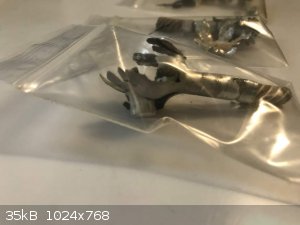
The spirit of adventure was upon me. Having nitric acid and copper, I had only to learn what the words 'act upon' meant. - Ira Remsen
|
|
|
ManyInterests
National Hazard
   
Posts: 966
Registered: 19-5-2019
Member Is Offline
|
|
It is very good. I went out on a field trip today to test out my blasting caps, and I even tried to set off (what I thought was) ammonium picrate.
This was my first expedition of the kind and... it's quite disappointing.
I wrote all my notes in a .txt file that I keep stored, but I am not in the mood to rewrite it, so I will put all my notes here for all to see:
The good:
The e-matches were perfect. No failures to ignite whatsoever. Trigger mechanisms also worked without issue. Note on the RF module. Only connect after
the charge has been wired and disconnect once it has been fired. Therefore I can safely say that my electric match design is near 100% effective.
List of caps tested:
First four caps made last March. Due to acid remaining in the ETN (not properly washed despite acetone recrystalization) the ETN was significantly
degraded. They were set off in a series and all popped quite well, but not as powerfully as expected. Possibly due to the degradation, but a more
likely culprit is the the plastic pen body.
Two further caps were tested, the newer ones. Despite the significantly improved melt-cast design, even the 1.3 grams of ETN (1 gram melt-cast) and
0.25 grams of dextrinated NHN, the detonations were not as loud or as powerful as expected.
The attempted main charge of ammonium picrate did not go off. Some fire started but was quickly put out. The lack of detonation could be that the
starting picric acid used to make the ammonium picrate was of poor quality and was not recrystalized. The 1st batch was off-color and the 2nd was the
salvaged remains of a runaway. a 2nd attempt will be made in the future, but with great care in regards to the manufacture of the picric acid and a
recrytalization will be done. Given just how readily the 'picric acid' dissolved in the 6% ammonia solution it could mean that most of it was not even
TNP, but possibly a great deal of MNP or DNP (MonoNitroPhenol and Dinitrophenol respective) that was turned into their far less explosive salts by the
ammonia.
Another possibility is that the detonator, despite being a 1.3 gram of ETN (1 gram melt-cast) simply didn't work.
The main issue is I feel I was greatly mistaken is the use of a plastic body for the blasting cap. I thought that NHN could easily go DTD in a cap
body or sustain the required explosive train. It is possible that the molten plastic is greatly interfering in the process. Even putting the plastic
body in a metal casing will likely not help due to the plastic issue. The bic round stic must be retired from further attempts and a more classical
metal body adopted.
Another possibility is that the dextrinated NHN is insufficiently powerful. After some conversation with a fellow discord chemist, the NHN doesn't
really need to be dextrinated. After reviewing the conservation it might not reduce the explosive power, but it might simply require more power, thus
more is required in the cap... either way, experiments will be done with dextrinated vs non dextrinated NHN.
Test done on current supply of NHN should be conducted to see if anything has changed in storage.
Next caps will continue to be electrical, but will use A: Spent firearm shells (will use both 7.62x51mm and the 7.62x54R. Some way to properly press
everything through the narrow neck will require experimentation), B: the steel tubes obtained from aliexpress, and c: Aluminum tubes that will be cut
to various lengths (I got a tube cutter!) and seal the other end with either epoxy or (following LL's methods), a piece of aluminum foil.
Further caps will feature the same melt-cast ETN, loose ETN, and NHN, but with no plastic wrapper between the NHN and ETN as I am confident that it is
not the chemical incompatibility between the two but the acid in the ETN. Which is no longer an issue.
-----
So that was that. My first det cap and how it blew away the wooden block I will write off as a one time fluke, because I could not replicate it. The
next time I will want to experiment more.
|
|
|
Laboratory of Liptakov
International Hazard
    
Posts: 1447
Registered: 2-9-2014
Location: Tel Aviv University
Member Is Offline
Mood: old jew
|
|
Proof of a good detonator function is the round and precise hole in the steel plate. Wood chips and sound mean nothing....Unfortunately....
Development of primarily - secondary substances: CHP (2015) neutral CHP and Lithex (2022) Brightelite (2023) Nitrocelite and KC primer (2024) Diper
60 (2025)
|
|
|
Hey Buddy
Hazard to Others
  
Posts: 443
Registered: 3-11-2020
Location: Bushwhacker Country
Member Is Offline
|
|
For cap bodies, I have found use of 8mm OD stainless steel, Aluminum or Ti drinking straws from china. They can be cut to length with a drill and pipe
cutter, then end closed with fireforming on a bearing with a torch or foil-stuffing the ends closed.
There is also a popular 6mm OD SS thermometer probe sheath. They can be found with the ends already closed in 6x50mm lengths.
I haven't used them yet so I can't claim they are in fact suitable but this is a ready-made option.
I believe they are listed on ebay generally as "Temperature Sensor PT100 casing"
SS 8mm straws
https://www.ebay.com/itm/224028065518
6x50mm probe casings
https://www.ebay.com/itm/354323121727
edit: just a recommendation, when testing detonators there is probability there will be failures, and it can be hazardous with several trials. A smart
practice I was taught is to leave ends always exposed so that they can be seen unobscured after failures. It gets nerve-racking to deal with failed
caps if they are covered with tape etc. from being connected to charges or det cord and the like.
[Edited on 6-11-2022 by Hey Buddy]
|
|
|
Laboratory of Liptakov
International Hazard
    
Posts: 1447
Registered: 2-9-2014
Location: Tel Aviv University
Member Is Offline
Mood: old jew
|
|
For laboratory testing and especially reliable DDT with exact results is best steel cavity 6/8 x 50 mm. (on pic.) Or 8/10 x 60 mm. In laboratory
conditions is possible trying without the metal (without any) plug. Because any obstacle on output side decrease and distorts results. Even thin alu
foil 0.3 mm distorts results. The strength and strength of the wall is decisive for the proper functioning of the DDT. The output side should always
be cast or highly pressed EM (segment). Which forms a solid plug on its own. The height of the pressed segment is usually 7 - 10 mm. For second side
with wires (or Bickford´s fuse) can be use the glue or else suitable method. For example grain and pressed BP (on picture) , or plasticized BP.
For first indicative results, 2 mm structural steel is most suitable. (on pic.)
A lead block is suitable for more accurate measurements (plate dent method).
For the most accurate measurement (plate dent method) aluminum block.
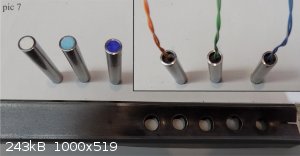
Development of primarily - secondary substances: CHP (2015) neutral CHP and Lithex (2022) Brightelite (2023) Nitrocelite and KC primer (2024) Diper
60 (2025)
|
|
|
ManyInterests
National Hazard
   
Posts: 966
Registered: 19-5-2019
Member Is Offline
|
|
Quote: Originally posted by Hey Buddy  | For cap bodies, I have found use of 8mm OD stainless steel, Aluminum or Ti drinking straws from china. They can be cut to length with a drill and pipe
cutter, then end closed with fireforming on a bearing with a torch or foil-stuffing the ends closed.
There is also a popular 6mm OD SS thermometer probe sheath. They can be found with the ends already closed in 6x50mm lengths.
I haven't used them yet so I can't claim they are in fact suitable but this is a ready-made option.
I believe they are listed on ebay generally as "Temperature Sensor PT100 casing"
SS 8mm straws
https://www.ebay.com/itm/224028065518
6x50mm probe casings
https://www.ebay.com/itm/354323121727
edit: just a recommendation, when testing detonators there is probability there will be failures, and it can be hazardous with several trials. A smart
practice I was taught is to leave ends always exposed so that they can be seen unobscured after failures. It gets nerve-racking to deal with failed
caps if they are covered with tape etc. from being connected to charges or det cord and the like.
[Edited on 6-11-2022 by Hey Buddy] |
Yes, metal bodies. That's the ticket! I can pick up metal straws at local dollar stores and other places. I don't know their exact diameter is, but
they can vary greatly. You mentioned 8mm ID. I will look into that. From what I've seen, real blasting caps tend to have an ID of 6mm or so, but I
guess larger can work just fine.
I also have some of those 6x50mm steel thermoprobes. For making smaller (real realistically sized) caps, they can work. I just need to make my
ematches as small as possible to allow room at the top for the epoxy plug.
I really want to make a blasting cap as good as a commercial/military cap. my mind is set on it!
Quote: Originally posted by Laboratory of Liptakov  | For laboratory testing and especially reliable DDT with exact results is best steel cavity 6/8 x 50 mm. (on pic.) Or 8/10 x 60 mm. In laboratory
conditions is possible trying without the metal (without any) plug. Because any obstacle on output side decrease and distorts results. Even thin alu
foil 0.3 mm distorts results. The strength and strength of the wall is decisive for the proper functioning of the DDT. The output side should always
be cast or highly pressed EM (segment). Which forms a solid plug on its own. The height of the pressed segment is usually 7 - 10 mm. For second side
with wires (or Bickford´s fuse) can be use the glue or else suitable method. For example grain and pressed BP (on picture) , or plasticized BP.
For first indicative results, 2 mm structural steel is most suitable. (on pic.)
A lead block is suitable for more accurate measurements (plate dent method).
For the most accurate measurement (plate dent method) aluminum block.
|
I have come to accept that you are correct about needing to test against metal and even though the results were impressive my first time around with
the wood, I was not able to replicate those results... so even that is a fluke.
I am willing to try to make a melt cast plug. But I don't know how to do it. I melt-cast my ETN by putting it in the pen body (now it will be the
metal body) and just put it in hot water (65C) to melt it inside the cap I want to use. But how would you make a simple plug? Because I do want to
make the test on metal, as well as doing the 'charge test'. As actually setting off a small charge of insensitive HE to see if it would actually go
off.
I did see your video on melt-cast ETN and I am afraid to say I am not willing to try it. Putting it on a teflon frying pan and melting it like that is
too scary for me.
[Edited on 6-11-2022 by ManyInterests]
|
|
|
XeonTheMGPony
International Hazard
    
Posts: 1641
Registered: 5-1-2016
Member Is Offline
Mood: No Mood
|
|
Ah yes my oldest of friends! I used those tubes for decade, I've since switched to aluminium.
They work excellent as a casing, and can be nickle plated if need be.
Figured I show recites this time, since I don't think I have befor
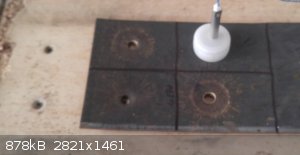
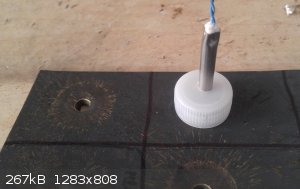
[Edited on 20-11-2022 by XeonTheMGPony]
|
|
|
XeonTheMGPony
International Hazard
    
Posts: 1641
Registered: 5-1-2016
Member Is Offline
Mood: No Mood
|
|
Quote: Originally posted by Herr Haber  | ETN melts around 55-61 depending on purity. Methanol boils at 65 so you dont have a big margin.
Because of this you'll probably have to use more methanol than needed because you dont want to have a blob of molten ETN in methanol. And if you let
it cool then you'll have a layer of ETN stuck at the bottom of a beaker.
Not the best for the nerves and this is where acetone becomes really useful to clean and save as much material as possible from the mess because you
dont really want to scrap if off right? 
But I'm pretty sure you already figured that last part out on your own.
I'd recommend starting with a 10g batch, just so you can get used to how much methanol you'll need and how much water to crash it in. If the ratio
methanol / water is too high it'll be very obvious to you. |
what on earth have you guys been doing? I have never even had close to these issues you speak of?!?!
|
|
|
Laboratory of Liptakov
International Hazard
    
Posts: 1447
Registered: 2-9-2014
Location: Tel Aviv University
Member Is Offline
Mood: old jew
|
|
XeonTheMGPony.....Finally someone, who can do it quality exact hole in steel..... ....Thanks for pictures. ....Thanks for pictures.
Development of primarily - secondary substances: CHP (2015) neutral CHP and Lithex (2022) Brightelite (2023) Nitrocelite and KC primer (2024) Diper
60 (2025)
|
|
|
Ankit1612
Harmless

Posts: 32
Registered: 2-11-2022
Member Is Offline
|
|
I'm using HMTD as primary explosive. And an empty pen as detonator casing.
I have PETN and Picric Acid which one is best as base charge in detonator?
|
|
|
underground
National Hazard
   
Posts: 715
Registered: 10-10-2013
Location: Europe
Member Is Offline
|
|
PETN, however i have failed to initiate PETN using HMTD in straw. ETN has no problem thought. Consider making some ETN too
[Edited on 22-11-2022 by underground]
|
|
|
Herr Haber
International Hazard
    
Posts: 1236
Registered: 29-1-2016
Member Is Offline
Mood: No Mood
|
|
Just exploring the 999 ways that dont work when we know one that works 
The spirit of adventure was upon me. Having nitric acid and copper, I had only to learn what the words 'act upon' meant. - Ira Remsen
|
|
|
ManyInterests
National Hazard
   
Posts: 966
Registered: 19-5-2019
Member Is Offline
|
|
Yeah, like I really didn't understand why my det caps didn't go off as well as I hoped. Maybe my dextrinated NHN is not good enough? Or maybe I need
more NHN in the cap than just 0.25g.
I got some advice to melt-cast the ETN in another beaker or watch glass, grinding it up again, then pressing it into the cap. I still can only
hand-press, which is a problem, but I will try with melted-in-cap and melt-cast then pressed.
|
|
|
XeonTheMGPony
International Hazard
    
Posts: 1641
Registered: 5-1-2016
Member Is Offline
Mood: No Mood
|
|
Quote: Originally posted by ManyInterests  | Yeah, like I really didn't understand why my det caps didn't go off as well as I hoped. Maybe my dextrinated NHN is not good enough? Or maybe I need
more NHN in the cap than just 0.25g.
I got some advice to melt-cast the ETN in another beaker or watch glass, grinding it up again, then pressing it into the cap. I still can only
hand-press, which is a problem, but I will try with melted-in-cap and melt-cast then pressed. |
All mine are pressed, never done melt cast, first 400mg is hard pressed 100mg light press. terribly subjective I know, I do plan to build a press
machine that will allow much more quantifiable measurements at some point
|
|
|
Laboratory of Liptakov
International Hazard
    
Posts: 1447
Registered: 2-9-2014
Location: Tel Aviv University
Member Is Offline
Mood: old jew
|
|
Casting is much more laborious and the output brisance is no better. When pressed into a solid cavity using a small vise, the density of ETN reaches
1.7g/cc or higher. It's the easiest and fastest. Usually 300 - 400 mg of ETN is pressed. This is followed by manual compression of 100 mg of ETN with
hand pressure of approx. 2 - 5 Kg. This is followed by a primary mixture, usually 200 mg. NHN has proven to be an unreliable substance. The most
reliable is 200 mg of SA-DS. In its own plastic case together with a resistance bridge. The use of plastic shrink tubing has been proven. SA-DS is
poured loosely and secured with a piece of nitrocellulose cotton wool.
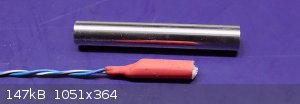
The side with the wires is completed with baking soda. And drips 4 drops of instant glue. This results in a very strong plug made of a relatively
inert and cheap and available material. And it holds immediately.
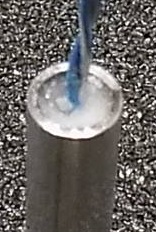
Development of primarily - secondary substances: CHP (2015) neutral CHP and Lithex (2022) Brightelite (2023) Nitrocelite and KC primer (2024) Diper
60 (2025)
|
|
|
Industrial Adhesive
Harmless

Posts: 15
Registered: 30-11-2018
Location: to be honest, I lost track
Member Is Offline
|
|
Quote: Originally posted by MineMan  | | Very cool! Would be curious about PETN and nano Al. Which can be set off by a low powered laser (1watt) no primary needed. |
would something like a fibre op cable be used as a lead?
i wonder if something with a higher thermal conductivity like copper would have a greater effect? problem is how easy it is to oxidize Al compared to
Cu making Al more desirable. im intrested if nano Cu/PETN could have a similar effect. or maybe some other nano metal powders.
|
|
|
| Pages:
1
..
8
9
10
11
12
..
18 |